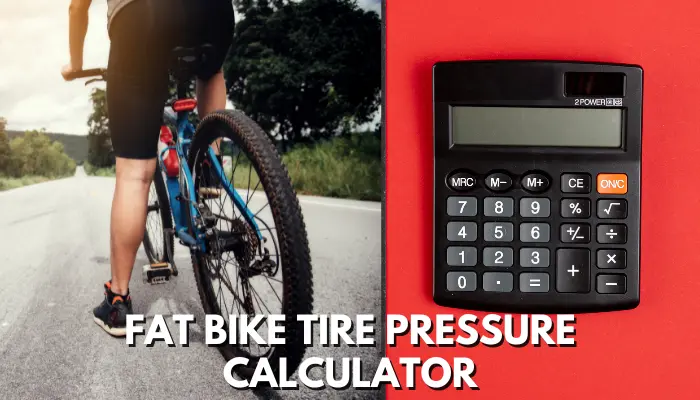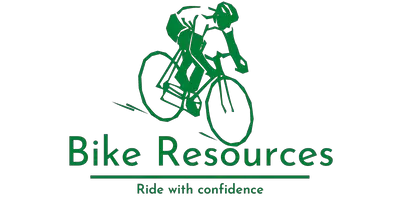Fat Bike Tire Pressure Calculator

In this era of growing popularity, people still look towards fat bike tires with tremendous curiosity. When the bikes with these tires are out of the garage, they get a lot of attention due to their strange contraptions.
Indeed there is a reason behind bikers’ love for fat bike tires; it’s just because you can ride your bike with fat tires in summers and winters. However, fat bike tires use relatively low pressure, so it is difficult for a regular floor pump to Gauge it.
A fat bike tire pressure calculator will help in this situation as it will help you set perfect pressure in your fat bike tire. This calculator will consider factors like tire size and weight and recommend the ideal strain for a safe and best riding experience.
Fat Bike Tire Pressure Calculator:
Fat Bike Tire Pressure Calculator
Recommended Tire Pressure: 0 PSI
Generally, a fat bike tire pressure calculator is a tool for bikers that will help you determine the perfect pressure for your bike according to the weather. Just with the help of our pressure calculator, you can easily set up the exact pressure for your fat bike tire. Everything you need to know before using this pressure calculator is below. Here is the pressure calculator you need for a perfect riding experience.
Importance Of Using A Pressure Calculator:
No doubt proper pressure in your fat bike tire can improve the performance of your bike. Apart from that quantity of stress in your tire will decide how much the tire will touch the ground. The pressure of your bike tire will directly affect three factors e-handling, bike traction, and rolling resistance.
Always remember that the lowest pressure of your tire will make more extensive contact with the ground, automatically decreasing the tire resistance. We all know that more resistance means more chances of punctures, rim impact, and sidewall damage.
Similarly, if your tire’s pressure is too high, it is also unsuitable for your fat bike tire as it will decrease the rolling resistance or traction. And this will more likely happen on slick surfaces. Moreover, the higher pressure of your tire can increase the vibration, resulting in an uncomfortable riding experience.
This means adjusting proper pressure for your fat bike tire is essential. To get the correct pressure, you surely need a fat bike tire pressure calculator. With the help of a pressure calculator, you can decrease the chance of injury and make your ride more comfortable.
Factors Affecting Fat Bike Tire Pressure Calculation:
The elements on which overweight bike tire pressure depends are given below:
- Weight of the bike rider
- Style of your riding
- Type of terrain on which you ride
Each factor has a different effect on the calculation. If there is a heavier rider, he will need higher tire pressure than the lightweight rider. If the tire pressure is lighter, it can cause bottoming out the tire, especially if you are riding rocking terrains.
On the other hand type of terrain is also a factor affecting tire pressure. A rider who mostly rides on soft surfaces like sand or snow can easily survive with lower tire pressure. But a gravel or road rider should alter the pressure a bit higher.
Generally, fat bike tires have optimal pressure ranging between 5 to 30 PSI. But the type can be changed according to the terrain you are riding on.
Benefits Of Using A Fat Tire Pressure Calculator:
If you want to increase the quality of your ride and make your ride more comfortable and safe, you will only need a fat bike tire pressure calculator. Here is what it will do for you:
- Get a comfortable ride:
Indeed if you know the correct pressure of your bike and you can alter it according to the condition, it will make your riding experience comfortable. This pressure calculator will tell you the exact pressure according to the type of terrain you will ride, your riding style, and the rider’s weight.
- Better control of your bike:
Correct pressure will decrease the traction and rolling resistance, making your ride smooth with better control. So you can enjoy your riding with confidence and safety.
- Adjust the pressure according to your weight:
The weight of a rider has a vast effect on the fat tire pressure. You will need to save your bike tire from bottoming, so you should have a proper gadget for knowing the correct pressure. And this is why you should use a pressure calculator.
- Save money:
One of the major perks of having a pressure calculator is that you know the correct pressure according to the terrain. This will decrease the chances of punctures or damage. This means no need to pay again and again for repair.
Fat Bike Tire Pressure Calculator For Altering Pressure:
Different conditions affect the pressure of your bike tire differently. So you should know that soft snow needs other traction as compared to hard snow. As well as riding on sand is different than riding on asphalt.
You can alter the grip of your fat bike tires in two ways: one, you can change the bike tire according to tread patterns or use the pressure calculator to get the correct pressure in the second case. The most used and cost-effective way is to alter the pressure according to terrain, so here are the conditions that need alteration of bike tire pressure.
Hard vs. Soft Terrains:
Adjusting tire pressure is all about soft ice or sand or hard-packed asphalt or ice. So the only that matters is whether you are riding on a soft or hard surface.
Soft conditions:
Soft conditions mean riding right after a snowfall when the tracks are all covered by soft snow. You can also call it soft condition when the temperature climbs to a specific point causing hard-packed trails to melt and weaken. If it’s not snow, in another case, the sift condition refers to sand or wet, muddy tracts.
In any benign condition scenario, we only want to keep you trying to bog down in mud, sand, or snow. Most riders say that the size of fat bike tires is enough to keep them floating on this surface. To some extent, they are right. But in some cases, you should also alter the pressure to increase the traction and make it float in soft conditions.
Keeping the fat bike tire pressure low in soft conditions is best because when you sit on the bike, your weight is also applied to it, flattening the tires. Similarly, flattened surfaces mean increased surface area improving the grip on soft conditions.
Hard-packed conditions:
Hard-packed conditions are more common in winter when the routes have no snow but a lot of traffic. After combining the daytime thawing with freezing nights of winter, it ends up having rock-hard tracts for fat bike tires.
In these conditions, floating doesn’t make any issue, but you have to adjust the rolling resistance here. The majority of the riders prefer riding on a bike longer and faster. This means the bike tires should have lower rolling resistance.
And you can achieve it by increasing the pressure of your fat bike tire.
Trying to run your bike in a hard-packed condition with lower tire pressure can increase the rolling resistance and make your tire contact with the surface and float. So if you improve the pressure, it will make your tire lesser contact with the surface resulting in decreased Rolling resistance.
Mixed conditions:
It was when things got complicated. You can either decrease or increase the pressure in mild or hard-packed conditions. But these terrain conditions are only sometimes as straightforward as they appear to be. Sometimes you need to know when the weather will change, which will constantly change from soft to complex.
Now changing the tires is a lot of cost-efficient and cost-effective. Also, it is unfeasible if the conditions are mixed. So here, you need to use a fat bike tire pressure calculator to adjust the pressure somewhat in the middle. Not too high or not too low.
FAQs
What will be the pressure of 26 fat bike tires?
The pressure of 26 fat bike tires is usually between 5 to 30 PSI. But the pressure of your fat bike tire also depends on the weight and height of the rider.
What PSI should I run on my fat bike in softer conditions?
In softer conditions, specifically in snow, the PSI is between 3 to 10. Also, the rider’s weight and other conditions affect the pressure.
How to pump up fat bike tires?
To pump up fat bike tires, you will need a pump having a wide barrel and a pressure Gauge that is capable of holding lower pressures. Just unscrew the valve cap, attach the pump, and fill the pressure in your fat bike tire according to the condition.
What PSI should fat bike tires be?
On fat bike tires, there are different PSI according to the rider’s weight, tire width, and tire pressure.
What will be the fat bike tire pressure with tubes?
If you have a tube-fat bike tire, adjust the pressure according to the manufacturer’s suggestion and the rider’s weight. As these, both factors had a significant effect on the pressure.
Usually, the tube fat bike tires have 5 to 30 PSI which is best for riding off-road and on snow with lower pressure. And with huger pressure, you can easily ride on paved surfaces.
What is the correct pressure for a 4-inch fat bike tire?
As we know, the weight of the rider and the manufacturer’s suggestion is significant while adjusting the pressure. Usually, if you have a 4-inch flat tire, its force will be 5 to 30 pounds.
Conclusion:
If you have the best fat tire bike, having the correct tire pressure according to the condition will feel fantastic. We have mentioned all the necessary things you need to know to set up perfect tire pressure with the help of our fat bike tire pressure calculator. It will enhance your riding experience. And make you feel more comfortable and safe—moreover, no need to change the tire for perfect pressure. You have to use this calculator and adjust the pressure accordingly.
